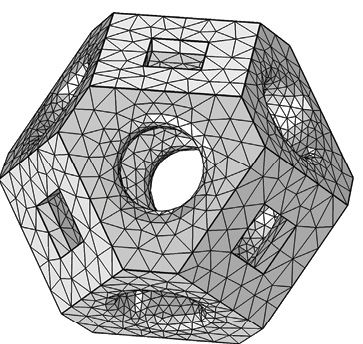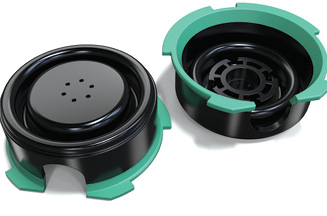Shatter Multimaterial Barriers

A meshed model showcases how a unit cell can deliver different material properties for metal 3D printing. Image courtesy of TNO via COMSOL.
Latest News
October 1, 2017
The U.S. Department of Energy’s (DOE) first Manufacturing Demonstration Facility (MDF), established at the Oak Ridge National Laboratory (ORNL), is leading efforts to revitalize American manufacturing. As part of a charter to break down barriers, the facility has taken on notable large-scale 3D printing challenges, including outputting automobiles, a house and a trim tool used to manufacture a wing for a Boeing passenger jet (which set a Guinness Word Record for the largest solid 3D printed object). Its latest endeavor aims to push the boundaries of materials science to enable multimaterial 3D printing, the goal being to boost manufacturing innovation.
 A meshed model showcases how a unit cell can deliver different material properties for metal 3D printing. Image courtesy of TNO via COMSOL.
A meshed model showcases how a unit cell can deliver different material properties for metal 3D printing. Image courtesy of TNO via COMSOL.Key to its effort is the modification of one of the MDF’s large-volume 3D printers to output two different materials on a single object. The expanded system will be able to print polymer material in sizes up to 13 ft. long, 6.5 ft. wide and 8 ft. tall, and will also be retrofit with a pair of hoppers, dryers and lines to accommodate and tailor two different materials to allow varying properties to be produced based on different positions on a part.
“As you start looking at the design of systems or components, the question is: Can you utilize more than one material to come up with a solution to make a part lighter in weight, more elastic in one area or have better strength properties in another and perform better than it did previously?” asks Bill Peter, director of the ORNL MDF. “The ability to leverage additive manufacturing to change materials as you go opens up a new tool set that hasn’t been available before.”
Research organizations like the ORNL MDF aren’t the only ones pursuing efforts to evolve multimaterial 3D printing. Leading 3D printer manufacturers, including Stratasys and 3D Systems, along with relative newcomers like HP and Autodesk, are introducing advanced technologies and new 3D printing paradigms to allow two or more materials to be printed simultaneously. The upside for design engineers is far ranging—from the simple benefit of printing support structures in a mode that’s different from the primary build material to adding color or tactile qualities to a prototype to the real cutting-edge—allowing the mixing of materials to achieve specific engineering properties that might be impossible to achieve with traditional production methods.
“Historically, when you designed a part, you looked at the existing manufacturing technologies and how to fabricate for a particular geometry, but there were limits as to what was possible,” Peter explains. “Thanks to additive, we can start thinking about new ways for multiple materials to come together, how structures can come together and how well each part will perform.”
Mix and Match Materials
At ORNL, the task involves exploring materials science and developing techniques that leverage the layer-by-layer extrusion or fusion process of 3D printing to vary the materials as well as the material composition to achieve certain behavioral or structural characteristics, explains Vlastimil Kunc, leader of ORNL’s polymer materials development team. For example, a design engineer might want certain properties on the surface of a part, but an entirely different makeup for the interior—a scenario that is next to impossible to achieve with current 3D printing technology. The team is exploring ways to switch, for example, from carbon fiber-filled thermoplastic to glass fiber-filled thermoplastic or even going from a metal material to a polymer. Although the efforts are clearly exploratory, Peter says ONRL’s goal is to work with industry players to commercialize technologies based on its ongoing research.
“The nice thing about additive is you can switch materials as you go or mix and grade materials as you go,” he explains. “It also lets you design in complex interfaces that might allow you to have two typically incompatible materials in direct contact.” Much of ORNL’s effort was driven by the team’s charter to 3D print large structures, which required some workarounds—for example, adding chopped carbon fiber or glass fiber to materials—to avoid deformation, Peter explains.
The Netherlands Organization for Applied Scientific Research (TNO) is also invested in exploring materials science and 3D printing. In one effort, the team is using COMSOL multiscale modeling and multiphysics simulation software to optimize microstructures to achieve different stiffness ratios and materials properties, which can be exploited by multimaterial 3D printers as they evolve, according to Marco Barink, a researcher at TNO. In one optimization study, Barink used COMSOL to investigate how to deliver twice the stiffness in one planar direction as the other in a single unit cell and in another he explored the spatial distribution and orientation of fibers in an anisotropic material.
As new generations of multimaterial 3D printers come on board with support for printing at a micro level, one could create new materials with tailored properties, affording engineers quite a bit of latitude in design performance, explains Barink. “What we’re exploring is how to make material that does what you want … with every spot on the product acting as you want,” he explains.
Vendors Up Multimaterial Game
In the near term, 3D printer vendors are doing their part to advance multimaterial capabilities. 3D Systems is appeasing its customers’ increased appetite for multimaterial capabilities through its inkjet technology and specifically its newly released MJP 5600 large-scale offering.
 3D Systems’ ProJet MJP 5600 multimaterial printer and VisiJet CR-BK rigid black plastic material deliver parts with enhanced mechanical performance. Image courtesy of 3D Systems.
3D Systems’ ProJet MJP 5600 multimaterial printer and VisiJet CR-BK rigid black plastic material deliver parts with enhanced mechanical performance. Image courtesy of 3D Systems.“You can take two thermoplastics and layer them one by one to get some mechanical benefits, but when you go to an inkjet model, you chemically change the results,” says Derek Johnson, 3D Systems’ director of MJP (multijet printing) product management.
The MJP 5600 will soon have good company. HP has announced detailed plans for its Multi Jet Fusion (MLF) 3D printing technology, which supports voxel-level control over color and mechanical capabilities as part of its support for multicolor, multimaterial 3D printing along with an open materials approach. For its part, Autodesk is said to have a patent covering different methods of fused filament fabrication 3D printing to enable multiple colors and nozzles as part of its 3D printing/digital manufacturing efforts.
 Proto Labs has adapted its overmolding processes to support multimaterials to enable more realism in prototypes. Image courtesy of Proto Labs.
Proto Labs has adapted its overmolding processes to support multimaterials to enable more realism in prototypes. Image courtesy of Proto Labs.Proto Labs, which provides rapid manufacturing services, is seeing growing demand for multimaterial capabilities among customers using both its overmolding and 3D printing services, for prototyping and for limited production run applications, according to officials. In response, the company has refined its overmolding process to be faster and less costly, explains Tony Holtz, Proto Labs marketing engineer. “We started doing this a year or so ago because customers wanted more realism, but they also wanted to get things done faster so they can test a part before going to market,” he explains.
For the 3D printing side of its business, Proto Labs sees similar applications driving demand for multimaterial capabilities, says Eric Utley, application engineer. The firm employs Stratasys PolyJet multimaterial printers to deliver its services, which have been extremely popular among customers, he says.
 Palette+ transforms most 1.75 filament-based (FFF/FDM) 3D printers into a multimaterial solution. Image courtesy of Mosaic Manufacturing.
Palette+ transforms most 1.75 filament-based (FFF/FDM) 3D printers into a multimaterial solution. Image courtesy of Mosaic Manufacturing.In addition to the PolyJet J750 multimaterial printer, digital materials are a major part of the Stratasys multimaterials story. Material properties range from rubber to rigid and transparent to opaque, allowing for precise printing in layers as fine as 16 microns. The result is support for up to 1,000 composite material combinations, each with specific and predictable properties, while giving design engineers the opportunity to optimize designs, not just from the standpoint of the outer shell, but also the interior capabilities to achieve the characteristics they desire.
Changing the engineer’s mindset—from printing with a single material to designing the outer surface and interior—is paramount to evolving multimaterial 3D printing, as is refining CAD and simulation tools to exploit the medium, according to Ohad Meyuhas, Stratasys’ director of academic research and development for the education vertical.
“Once we train the industry to think about things in a different way, we will see these capabilities become much more prevalent in industry,” he says.
More Info
Subscribe to our FREE magazine, FREE email newsletters or both!
Latest News
About the Author
Beth Stackpole is a contributing editor to Digital Engineering. Send e-mail about this article to [email protected].
Follow DE





